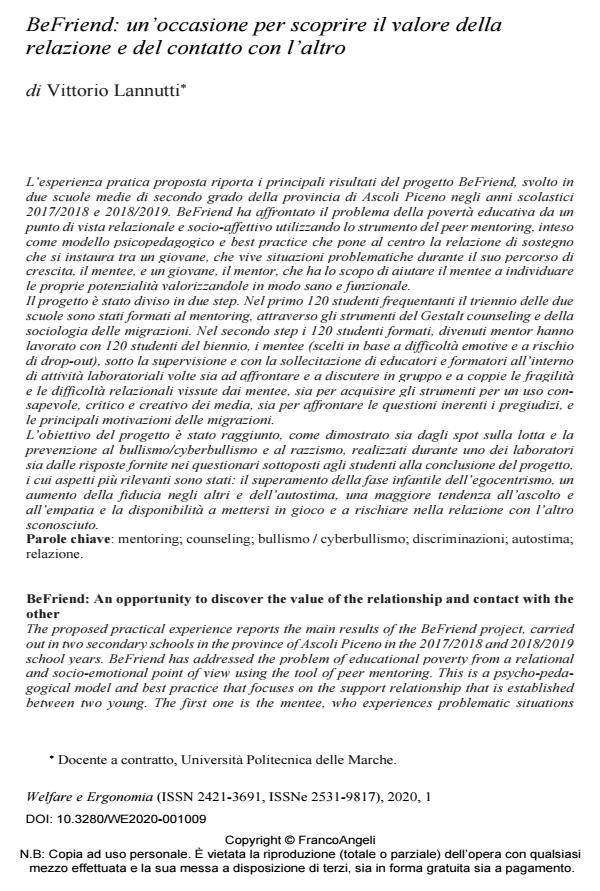BeFriend: un’occasione per scoprire il valore della relazione e del contatto con l’altro
Titolo Rivista WELFARE E ERGONOMIA
Autori/Curatori Vittorio Lannutti
Anno di pubblicazione 2020 Fascicolo 2020/1
Lingua Italiano Numero pagine 10 P. 91-100 Dimensione file 340 KB
DOI 10.3280/WE2020-001009
Il DOI è il codice a barre della proprietà intellettuale: per saperne di più
clicca qui
Qui sotto puoi vedere in anteprima la prima pagina di questo articolo.
Se questo articolo ti interessa, lo puoi acquistare (e scaricare in formato pdf) seguendo le facili indicazioni per acquistare il download credit. Acquista Download Credits per scaricare questo Articolo in formato PDF

FrancoAngeli è membro della Publishers International Linking Association, Inc (PILA)associazione indipendente e non profit per facilitare (attraverso i servizi tecnologici implementati da CrossRef.org) l’accesso degli studiosi ai contenuti digitali nelle pubblicazioni professionali e scientifiche
L’esperienza pratica proposta riporta i principali risultati del progetto BeFriend, svolto in due scuole medie di secondo grado della provincia di Ascoli Piceno negli anni scolastici 2017/2018 e 2018/2019. BeFriend ha affrontato il problema della povertà educativa da un punto di vista relazionale e socio-affettivo utilizzando lo strumento del peer mentoring, inteso come modello psicopedagogico e best practice che pone al centro la relazione di sostegno che si instaura tra un giovane, che vive situazioni problematiche durante il suo percorso di cre-scita, il mentee, e un giovane, il mentor, che ha lo scopo di aiutare il mentee a individuare le proprie potenzialità valorizzandole in modo sano e funzionale. Il progetto è stato diviso in due step. Nel primo 120 studenti frequentanti il triennio delle due scuole sono stati formati al mentoring, attraverso gli strumenti del Gestalt counseling e della sociologia delle migrazioni. Nel secondo step i 120 studenti formati, divenuti mentor hanno lavorato con 120 studenti del biennio, i mentee (scelti in base a difficoltà emotive e a rischio di drop-out), sotto la supervisione e con la sollecitazione di educatori e formatori all’interno di attività laboratoriali volte sia ad affrontare e a discutere in gruppo e a coppie le fragilità e le difficoltà relazionali vissute dai mentee, sia per acquisire gli strumenti per un uso consapevole, critico e creativo dei media, sia per affrontare le questioni inerenti i pregiudizi, e le principali motivazioni delle migrazioni. L’obiettivo del progetto è stato raggiunto, come dimostrato sia dagli spot sulla lotta e la pre-venzione al bullismo/cyberbullismo e al razzismo, realizzati durante uno dei laboratori sia dalle risposte fornite nei questionari sottoposti agli studenti alla conclusione del progetto, i cui aspetti più rilevanti sono stati: il superamento della fase infantile dell’egocentrismo, un aumento della fiducia negli altri e dell’autostima, una maggiore tendenza all’ascolto e all’empatia e la disponibilità a mettersi in gioco e a rischiare nella relazione con l’altro sco-nosciuto.
Parole chiave:Mentoring; counseling; bullismo / cyberbullismo; discriminazioni; autostima; relazione.
Vittorio Lannutti, BeFriend: un’occasione per scoprire il valore della relazione e del contatto con l’altro in "WELFARE E ERGONOMIA" 1/2020, pp 91-100, DOI: 10.3280/WE2020-001009